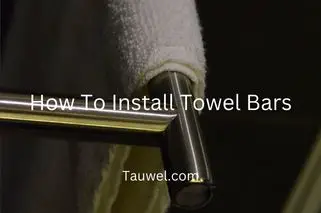This post contains affiliate links. Read the full disclosure here.
There can be a lot of reasons why you would want to hang or mount something on tiled walls. Ranging from bathroom accessories to decorative items. There is a range of products to choose from. It can be confusing how to get it done. Mounting items the wrong way can end up damaging tiles or the items themselves might fall and break after some time. Let’s take a look at how to correctly mount items on tiles.

To mount things on tiles you can either use an adhesive strip directly on the tile or drill into the tiles. Use masonry drill bits and a slab of wood in front of the drilling area to drill into the tiles so they don’t break. Use anchors in case there are no studs behind the drilling point.
Contents
How To Mount On Tiles Using A Drill?
Drilling holes and mounting items using screws is one of the more permanent methods of mounting anything on your tile wall. For example, drilling can be used to mount towel rings or towel bars. One downside of this method is that it can end up permanently damaging your tiles if not done correctly so take this into consideration. There is also a chance that drilling into the tiles the wrong way can crack or break the tile itself.
In a Hurry? Don’t go without checking this TRENDING Topic Out - 6 Best Towels For Blackstone Griddle In 2022 out
You will need a drill, a masonry drill bit, a permanent marker, a slab of wood, a hammer, anchors, screws, a screwdriver, and a Dremel. Some of these tools are there for failsafe in case one method isn’t working for you.
Mark the area where you want to drill the holes with a permanent marker. The tricky thing with drilling into tiles is that they can break. To prevent this, use the drill on the slowest setting while using masonry drill bits.
One of the other reasons for tiles cracking during the drilling process is the slight bounce at the beginning of drilling. To prevent this, use a Dremel and attach a very thin tip to it. Make a tiny hole or indent on the tile using the Dremel. This will give the drill a starting position so that it doesn’t bounce or wander off in the beginning.
If you don’t have a Dremel, you can also place a thin slab of wood on top of the drilling area and start drilling on top of the wood. This way the drill will have a smoother entry into the tiles.
While hanging anything, you will need to ensure that the screws have the proper grip to sustain their weight. To achieve this, either drill into the stud behind the wall or use an anchor to provide the grip.
To use an anchor, make an empty hole into the tiles and the wall and hammer the anchor into the wall to flush it. Don’t use too much strength while hammering otherwise it might damage the tiles.
Further mounting steps will depend on the type of item you want to mount or hang. Read the mounting instructions or ask the vendor before proceeding.
Mounting On Tiles Using Adhesive Strips
For smaller and lighter items using adhesive strips is the easiest and most cost-effective method you can use. For example, adhesives can also be used to mount towel bars or towel rings. There are a lot of options available in the market but the hanging strips from Command work the best.
Not only do they come in different sizes rated for different weights, but you can also use them in combination with each other to hang slightly heavier items. They don’t damage the tiles or leave a mark after use which makes them a great choice.
If you want to mount things that you might remove or change their location after some time then this method is the best option to go for.
Mounting Things On Tiles Using Liquid Nails
Liquid Nails is a heavy-duty construction adhesive. Even though it is usually used for construction work, you can also use it to mount or hang items on tiles. They are really strong and can sustain even hundreds of pounds of weight.
One downside is that it might end up damaging your tiles in the long run, but if your item is supposed to be mounted for a long time, then it shouldn’t be much of a problem. You can also use a caulk gun to squeeze out large quantities of the adhesive.
You might need to use a heavy-duty cleaning spray to remove the adhesive from your tiles after use.
Whenever hanging anything using Liquid Nails, make sure to provide support to the item overnight so that the adhesive can dry out.
Frequently Asked Questions
Let us take a look at some of the most common questions that people have related to hanging items on tiles.
Will The Tile Break While Using A Driller?
Use the drill on the slowest setting and make a smaller hole in the beginning to prevent any bouncing or wandering during the beginning which can lead to tile cracks.
Will Liquid Nails Damage Your Tiles?
Liquid Nails can end up damaging and leaving a mark on your tile. Although the adhesive itself can be removed later on with a heavy-duty cleaner.
Will Adhesive Strips Last For a Long Time?
The Command adhesive strips can last for a relatively long time, although they won’t last for years and it is not a permanent solution for mounting items.
Conclusion
The easiest method to mount things on tiles is using an adhesive strip or other professional adhesives but they will not provide enough grip for heavier and larger objects. For a more permanent solution, you will have to use a drill and screws. While drilling on tiles, use a smaller bit size and start at a slow speed to avoid bouncing the drill bit which can cause cracks. You can also use a small wood piece over the drilling area for a smoother entry into the tile.


